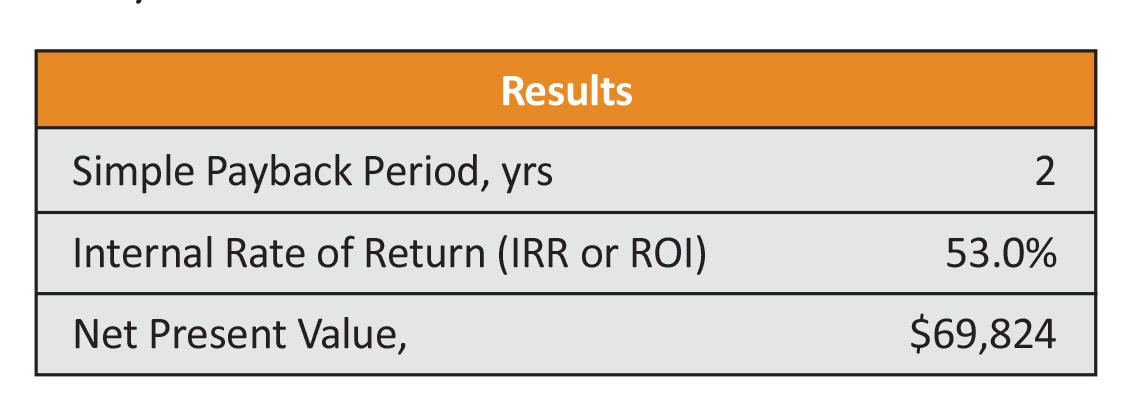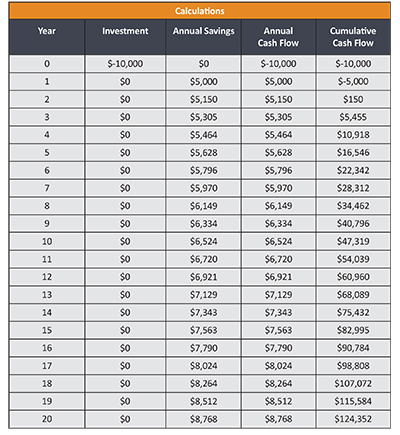Mechanical Insulation Simple Calculators: A Guide to the Financial Returns and Personnel Protection Calculators
As a part of
efforts by the Department of Energy’s Advanced Manufacturing Office to improve
the energy efficiency of the U.S. industrial and commercial sectors, the
National Insulation Association (NIA), in conjunction with its Alliance
partners, worked to design, implement, and execute the Mechanical Insulation
Education & Awareness Campaign (MIC).
The MIC is a program to
increase awareness of the energy efficiency, emission reduction, economic
stimulus potential, and other benefits of mechanical insulation. An integral
component of the MIC was the development of a series of “Simple Calculators.”
The calculators, listed below, provide users with instantaneous information on
a variety of mechanical insulation applications in the industrial/manufacturing
and commercial markets.
- Condensation Control for Horizontal Piping
- Energy Loss, Emission Reduction, Surface Temperature, and Annual Return
for Equipment and Piping - Insulation Financial Returns
- Estimate Time to Freezing for Water in an Insulated Pipe
- Personnel Protection for Horizontal Piping
- Temperature Drop for Air in an Insulated Duct or Fluid in an Insulated
Pipe
The calculators are online as part of the National Institute of Building
Sciences’ Mechanical Insulation Design Guide (MIDG), www.wbdg.org/design/midg_calculators.php. You can also access them through a link on NIA’s
website: www.insulation.org. The calculators are fast, free, and
functional tools that make it easy to discover energy savings, financial
returns, and other information for the design of mechanical insulation systems
for above- or below-ambient applications.
This article provides an
overview and a guide on how to use the Financial Returns Calculator and the
Personnel Protection for Horizontal Piping Calculator.
Insulation Financial Returns Calculator
Insulation systems are frequently designed with the
objective of minimizing costs. Properly designed insulation systems can reduce
heat loss or gain from (or to) mechanical systems by 90 to 98%. Since energy
must be purchased to offset these heat flows, insulation systems can quickly
pay for themselves in reduced energy costs.
Insulation projects, like many
energy-conservation projects, generally involve making an initial investment
that will result in future cost savings. A number of approaches can be used to
measure the financial desirability of an insulation project. All require
estimates of the initial investment (in this case, the installed cost of the
insulation system) and the resulting future savings. Some of these financial
measures are simple, like return on investment (ROI) and simple payback period.
Others are more complicated and take into account the time value of money,
inflation, and taxes.
This calculator was developed
to provide a convenient way to estimate the financial returns related to
investments in mechanical insulation: simple payback in years, internal rate of
return (IRR or ROI), net present value (NPV), and annual and cumulative cash
flow. It can be used for an overall mechanical insulation project or for a
small investment such as insulating a valve or replacing a section of
insulation. Tax implications of the investment have not been considered in the
Financial Calculator. You should consult your financial advisor for specific or
tailored financial calculations. (For further information on the definition of
terms used in the calculator, please refer to the MIDG website.)
The calculator requires input information for five variables. The
“Results” and “Calculations” sections are updated as each input variable is
entered. Here are instructions and additional information for each input
variable. Sample inputs appear in a box, after each instruction.
- Line 1. Enter the cost of installing or replacing insulation, $10000
The default value is $10,000. However, you may
enter any positive dollar amount. You may use the overall cost of a mechanical
insulation project, or a small mechanical insulation investment. - Line 2. Enter the estimated energy
cost savings during the first year, $/yr 5000The default value
is $5,000/yr; however, you should enter the estimated savings for the scope of
work you identified in Line 1. You can use the Energy Calculators for
Horizontal Piping and Equipment within the MIDG Simple Calculator section to
estimate the annual savings. See the March 2013 issue of Insulation Outlook
for instructionson on using the Energy Calculator for Horizontal Piping.- Line 3. Enter the projected
annual energy cost escalation rate, %/yr 3.0Energy cost savings after the first year are assumed to increase at the
energy cost escalation rate. The default value is 3%; however, you should enter
your best estimate of the percentage
that you expect the cost of your energy source to increase by
annually over the life of the scope of work identified in Line 1. - Line 3. Enter the projected
- Line 4. Enter the estimated economic life of the insulation system,
yrs 20The default value
is 20 years; however, you should enter your best estimate as to the expected
useful life for the scope of work identified in Line 1. - Line 5. Enter the discount rate
for NPV calculation, % 5.0
The default value is 5%. NPV is the difference between the present value
of cash inflows and the present value of cash outflows. The input box requires
selection of an appropriate discount rate, sometimes referred to as the “hurdle
rate” or the “required rate of return.” It should be established as equal to
the highest rate of return available on alternative investments of comparable
risk, or a company-established minimum threshold.
Based on the input information entered, the “Results” section provides
the calculated simple payback period, IRR or ROI, and NPV. An example using the
default values for all input variables is shown below. Note that the simple
payback is calculated as the initial cost divided by the first-year savings.
The calculator assumes that initial investment occurs at the beginning of Year
1, and annual savings occur at year-end. Savings after 20 years are ignored.
The “Calculations” section, using the default values for all input
variables, is shown below. This section illustrates the initial Investment, the
Annual Savings, Annual Cash Flow, and Cumulative Cash Flow over the economic
life of the application. Using the default value examples, a $10,000 initial
investment yielding $5,000 of first-year savings will yield $124,352 net of the
initial investment—before discounting—at the end of 20 years. The NPV of this
investment is $69,824.
Personnel Protection Calculator for Horizontal
Piping
As described on the MIDG—Simple Calculators web
page, this calculator estimates the maximum contact exposure time on the outer
surface of a horizontal pipe insulation system based on the potential for
contact burn injuries. Input requirements include the pipe size, operating
temperature, ambient temperature, wind speed, and details about the insulation
system (material and jacketing).
The maximum contact exposure
times are estimated using the procedures outlined in ASTM C 1055-03 (Reapproved
2009) Standard Guide for Heated System Surface Conditions that Produce Contact
Burn Injuries. This guide establishes a means by which the engineer, designer,
or operator can determine the acceptable surface temperature of a system where
contact may be made with a heated surface.
For the purposes of this calculator, the maximum contact exposure times
are based on an acceptable injury level of first degree burns (reversible
epidermal injury, or the limit represented by the lower “Threshold B” curve
shown in Figure 1 of the Standard). Acceptable contact times will depend
on the application. The Standard recommends, based on a survey of the medical
literature, 5 seconds for industrial processes and 60 seconds for consumer
items.
The insulation materials
included in this calculator were selected to be representative of some of the
materials commonly used in the industry. The list is not inclusive of all
materials types and other materials are available. The calculator does not
screen for material temperature limitations, so use caution when selecting the
materials.
For further information on the
thermal conductivity data used in the calculator, please refer to the MIDG
Personnel Protection Calculator for Horizontal Piping. Also note that some
materials are not available in all of the sizes and thicknesses covered, and
some are available in sizes and thicknesses not listed.
The calculator requires input
information for 6 variables. The “Results” section is updated as each input
variable is entered. Following are the instructions and additional information
for each input variable.
- Line 1. Select Nominal Pipe Size NPS 4
The default value is an NPS of 4″; however, you
can select any pipe size from ½” to 24″ from the drop down box. - Line 2. Enter operating (process) temperature, °F 800
The default value
is 800°F. You should enter the actual operating or process temperature. - Line 3. Enter average temperature of the air surrounding the pipe, °F
75The default value
is 75°F; however, you should enter the average surrounding or ambient operating
temperature, in Fahrenheit, for the area in question. - Line 4. Enter the wind speed of the ambient air (if unknown, use 0
mph for worst-case conditions) 10The default value
is 10 mph. However, when in doubt, use 0 mph, which represents the worst-case
conditions. - Line 5. Select an insulation material Mineral Wool (to 1200°F)
The default box
indicates Mineral Wool; however, you may select one of eight insulation
materials from the drop-down box: Calcium Silicate, Cellular Glass,
Elastomeric, Fiberglass, Mineral Wool, Polyethylene, Polyisocyanurate, or
Polystyrene. - Line 6. Select the effective emittance of the exterior surface
0.80 – Painted MetalThe default box
indicates painted metal; however, you may use the drop-down menu to select one
of twelve exterior surfaces. For a detailed discussion and definition of
emittance, please refer to the MIDG website.
The “Results” section, using
the default values for all input variables, is shown below. The section
illustrates, for a range of thicknesses of the insulation material selected,
the calculated surface temperature and resulting maximum contact time in
seconds.
Note that the Personnel Protection Calculator incorporates a number of
important simplifying assumptions. Refer to the MIDG web page for further
discussion of these assumptions.
Summary
While they do not address every insulation material
or application condition (thus the term, Simple Calculators), the Simple
Calculators are intended to provide the user with online, easily accessible,
snapshot information on some of the most frequently asked-about benefits and
design considerations of mechanical insulation systems.
Whether you need basic
insulation information or are designing a complex insulation system, MIDG (www.wbdg.org/design/midg_introduction.php)
is a tremendous resource for the novice or the experienced user. Along with the
calculators, it contains everything you need to know about the design,
selection, specification, installation, and maintenance of mechanical
insulation. MIDG is continually updated with the most current and complete
information, including the Simple Calculators. These tools can be very helpful
in designing a mechanical insulation system and they allow the user to easily
determine the many benefits and value of mechanical insulation.



